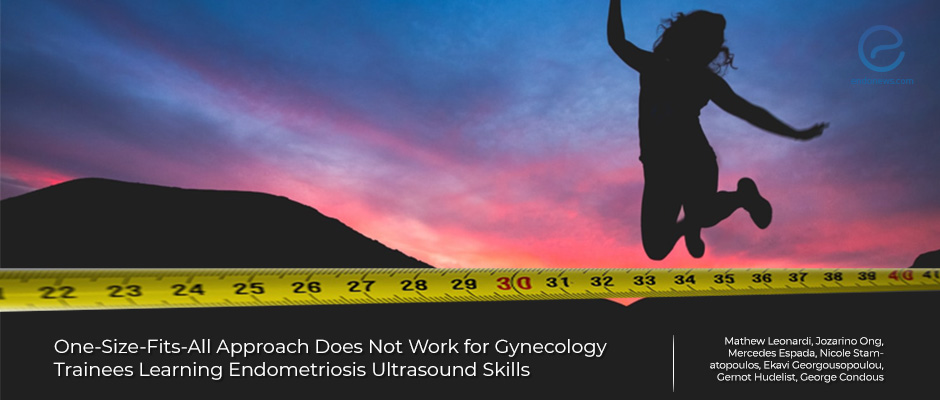Ultrasound diagnosis of endometriosis: One Size Does-Not-Fit-All
Jun 2, 2020
The diagnosis of endometriosis on Ultrasound requires focused, in-depth, and rigorous training to achieve appropriate competency
Key Points
Importance:
- What is the best way to instruct surgical trainees the ultrasound skills necessary to diagnose advanced endometriosis?
Highlights:
- The detection of deeply infiltrating endometriosis (DIE) to the colon and pouch of Douglas (POD) obliteration via transvaginal US (TVUS) requires a significant amount of technical skill and experience.
What’s done here:
- This study followed three advanced gynecologic surgical fellows for one year while they underwent TVUS training to evaluate the minimum number of TVUS scans necessary to gain clinical competency.
Key Results:
- From a total of 150 transvaginal ultrasound (TVUS) examinations, it was found that one trainee did not reach competency while the other two fellows achieved competency by the 21st and 25th TVUS examination for the diagnosis of bowel deep endometriosis.
- For the evaluation of Douglas pouch obliteration, one fellow did not reach competency while two other fellows reached competency by the 22nd and 40th TVUS examination.
- The prevalence rates of bowel deep endometriosis and Douglas obliteration were 17.9% (26 of 145 patients) and 23.4% (34 of 145 patients).
- Fifty TVUS examinations were not enough to achieve clinical competency in at least 1 out of 3 gynecologic surgical fellows for the diagnosis of colon endometriosis and POD obliteration.
Limitations:
- This study observes a very limited and specific trainee population, namely 3 gynecologic surgical fellows with significant inter-trainee variability in prior TVUS experience.
- Trainees knew prior to the TVUS session that they are evaluating for endometriosis however they were blind to patients’ medical history and physical examination findings.
- The trainees’ performance was compared to another diagnostician’s assessment rather than laparoscopic/histologic findings. Thus, further studies are required to determine the best approach and application of TVUS training more accurately for the detection of endometriosis.
Lay Summary
Deeply infiltrating endometriosis (DIE) is an advanced form of endometriosis that causes significant morbidity to many women. The Pouch of Douglas (POD), otherwise known as the rectouterine space, is the anatomic area between the posterior cervix and anterior rectum. Its obliteration on ultrasound (loss of this anatomic space due to fibrosis) has been used as a marker for endometriosis involvement of the bowel. The assessment of endometriosis on transvaginal ultrasound (TVUS) is technically challenging and due to the clinical heterogeneity of endometriosis, the diagnosis of endometriosis requires a significant amount of experience. Physician trainees including diagnostic radiology residents and gynecologic surgical fellows need to be acquainted with the diagnosis of endometriosis. However, the best method to teach TVUS skills for the diagnosis of endometriosis is not standardized.
This study followed three advanced gynecologic surgical trainees (fellows) while they underwent TVUS training in a tertiary endometriosis clinic in Sydney, Australia over a 12-month period between December 2017 in order to evaluate the minimum number of TVUS scans necessary to gain clinical competency for the diagnosis of DIE to the colon and POD obliteration. TVUS examinations were performed and reported independently by the fellows. A standardized educational program preceded study initiation. This involved self-directed theoretical learning through the reading of key publications (including viewing figures and supplementary figures and videos). Videos of positive and negative sliding signs in anteverted and retroverted uteruses were included. In addition, fellows were present during 5 routine expert-guided TVUS examinations by an expert sonologist, during which all fellows had the opportunity to witness bowel DE and POD obliteration in real-time. Each fellow performed 50 predetermined studies expert-guided TVUS examinations by focusing on bowel and POD assessment, consecutively. Fellows were blinded to the clinical and surgical histories of all patients as well as the reference standard findings of the ES. They were aware that all patients were being evaluated for endometriosis. These trainees also had varying experiences in formal gynecologic US before the study began. The cumulative summation test for the learning curve was adopted for this study to objectively define skill competency.
Of 150 patients identified as suitable for the study, 5 patients declined consent and participation during the period. Five patients underwent 2 index test TVUS examinations by 2 separate fellows, bringing the total number of index test TVUS examinations to 150. The mean age of the participants was 31.5 +/- 6.4 years. The median gravidity and parity were 0 [0–2] and 0 [0–1], respectively. The presenting symptom in the majority of these patients was dysmenorrhea, and/or dyspareunia. The prevalence rates of bowel DE and POD obliteration were 17.9% (26 of 145 patients) and 23.4% (34 of 145 patients). From a total of 150 transvaginal ultrasound (TVUS) examinations, it was found that one trainee did not reach competency while the other two fellows achieved competency by the 21st and 25th TVUS examination for the diagnosis of bowel deep endometriosis. For pouch of Douglas's obliteration, one fellow did not reach competency while two other fellows reached competency by the 22nd and 40th TVUS examination.
This study demonstrates that it is feasible for some, but not all, gynecologic fellows, with varying or limited experience in the gynecologic US, to learn specialist US detection of POD obliteration and DE of the bowel in a predetermined program of 50 TVUS examinations.
Research Source: https://pubmed.ncbi.nlm.nih.gov/32412170/
ultrasound imaging resident physician trainee rectouterine space culdesac Douglas colon bowel

